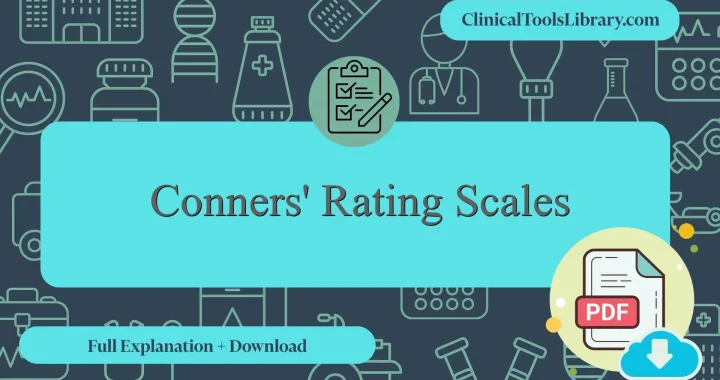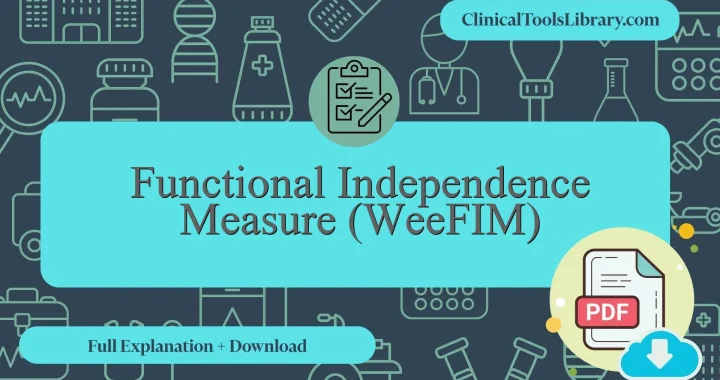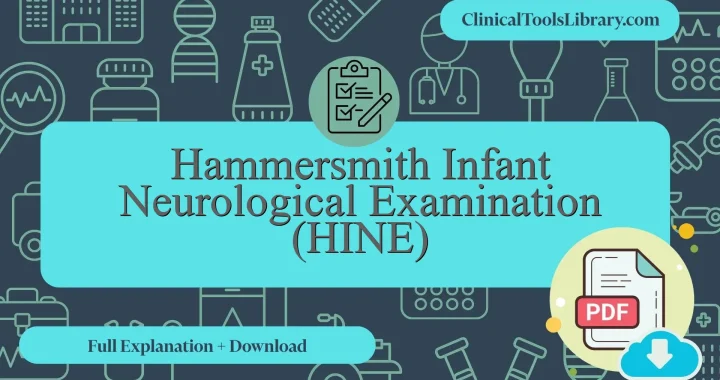In this article, we explain everything you need to know about the Conners’ Rating Scales. We will cover the aspects it evaluates, the target population, a detailed step-by-step explanation, and how to interpret its results. Additionally, we will dive into the scientific evidence supporting this tool (diagnostic sensitivity and specificity) in clinical assessment. You will also find official and unofficial sources available for download in PDF format.
What does the Conners’ Rating Scales assess?
The Conners’ Rating Scales are standardized assessment tools designed to evaluate behavioral symptoms associated with Attention-Deficit/Hyperactivity Disorder (ADHD) and related disruptive behavior disorders in children and adolescents. These scales provide structured input from parents, teachers, and clinicians to measure symptom severity across domains such as inattention, hyperactivity, and impulsivity. The main purpose of the Conners’ Rating Scales is to facilitate accurate identification and monitoring of behavioral problems, supporting diagnostic and treatment planning processes. Clinicians often refer to resources like the Conners Rating Scale pdf scoring or the Conners Parent Rating Scale manual for standardized administration and interpretation guidelines. The scales include specific scoring sheets and manuals, such as the conners’ rating scale manual pdf, to ensure consistent application and reliable clinical outcomes.
For which type of patients or populations is the Conners’ Rating Scales intended?
The Conners’ Rating Scales are primarily indicated for pediatric patients aged 6 to 18 years suspected of exhibiting symptoms consistent with Attention-Deficit/Hyperactivity Disorder (ADHD) and related behavioral disorders. These scales are most useful in clinical settings such as child psychiatry, psychology, and developmental pediatrics to obtain multi-informant assessments from parents, teachers, and clinicians. Utilization of standardized tools like the Conners Parent Rating Scale manual enhances diagnostic accuracy by providing objective measures of symptom severity and behavioral patterns. Furthermore, the scales facilitate monitoring treatment response and guiding intervention strategies through systematic scoring and interpretation, often referenced in resources like the Conners Rating Scale pdf scoring guidelines. Their application is critical when differential diagnosis is necessary to distinguish ADHD from other neurodevelopmental or emotional disorders in complex clinical presentations.
Step-by-Step Explanation of the Conners’ Rating Scales
The administration of the Conners’ Rating Scales begins with selecting the appropriate form, typically comprising 27 to 80 items, depending on the version (Short Form or Comprehensive). Each item assesses behaviors related to Attention-Deficit/Hyperactivity Disorder (ADHD) and related disorders, utilizing both symptom frequency and severity questions. Respondents, often parents or teachers, rate each behavior on a 4-point Likert scale ranging from “Not at all” (0) to “Very much” (3). The clinician ensures clarity by providing standardized instructions emphasizing the observation period, usually the past month. Upon completion, scores are tallied according to the scale’s diagnostic algorithms to identify symptom clusters in domains such as inattention, hyperactivity, and impulsivity, facilitating an objective assessment of behavioral concerns in children and adolescents.
Download Conners’ Rating Scales PDF | Original & English Versions with Scoring Sheets for ADHD
Professionals and caregivers will find downloadable resources for the Conners’ Rating Scales available below, including both the original and English versions in PDF format. These materials encompass the Conners Rating Scale pdf free download, as well as the Conners Rating Scale scoring sheet, designed to facilitate accurate assessment and interpretation. Such documents are essential tools for evaluating conditions related to ADHD and other behavioral disorders, ensuring standardized and reliable measurement across diverse populations.
How to interpret the results of the Conners’ Rating Scales?
Interpretation of the Conners’ Rating Scales involves comparing raw scores against standardized reference values, typically represented as T-scores with a mean of 50 and a standard deviation of 10. Scores above 65 suggest clinically significant symptoms related to Attention-Deficit/Hyperactivity Disorder (ADHD) or other behavioral concerns. The formula for converting raw scores to T-scores is T = 50 + 10 × ((X – M) / SD), where X is the individual’s raw score, M is the mean of the normative sample, and SD is the standard deviation. For healthcare professionals, elevated T-scores indicate the need for further comprehensive evaluation and may guide diagnostic decisions, treatment planning, and monitoring of symptom progression or response to interventions.
What scientific evidence supports the Conners’ Rating Scales ?
The Conners’ Rating Scales, originally developed in the 1960s by Dr. C. Keith Conners, have undergone extensive validation to assess behavioral concerns primarily associated with Attention-Deficit/Hyperactivity Disorder (ADHD). The scales have demonstrated strong psychometric properties, including high internal consistency and test-retest reliability across diverse populations. Numerous studies have confirmed the tool’s criterion validity through comparisons with clinical diagnoses and other standardized assessments. Normative data were established from large, representative samples, enabling accurate differentiation between typical and atypical behaviors. Additionally, factor analyses have consistently supported the underlying constructs measured by the scales, such as inattention and hyperactivity/impulsivity, solidifying their utility in both clinical and research settings.
Diagnostic Accuracy: Sensitivity and Specificity of the Conners’ Rating Scales
The Conners’ Rating Scales demonstrate a sensitivity ranging from approximately 70% to 90% in identifying symptoms associated with Attention-Deficit/Hyperactivity Disorder (ADHD), depending on the specific version and population studied. Their specificity is generally reported between 80% and 95%, indicating a strong ability to correctly exclude individuals without the disorder. Variability in these metrics is influenced by factors such as the informant source (parent, teacher, or self-report) and the clinical setting. Overall, the scales offer robust psychometric properties that support their use as reliable screening tools in both research and clinical practice.
Related Scales or Questionnaires
The Conners’ Rating Scales are frequently compared to other established instruments such as the Vanderbilt Assessment Scales, the Swanson, Nolan, and Pelham IV (SNAP-IV) Rating Scale, and the Child Behavior Checklist (CBCL), each of which is thoroughly detailed on ClinicalToolsLibrary.com. The Vanderbilt scales offer comprehensive evaluation of ADHD symptoms and comorbid conditions but may require more time to administer compared to Conners. The SNAP-IV, notable for its brevity and focus on core ADHD criteria, provides ease of use but may lack the depth for broader behavioral assessment. The CBCL covers a wide range of emotional and behavioral problems but is less specific to attention disorders. All these tools, including the Conners Rating Scale versions such as the Conners Parent Rating Scale manual and the Conners ADHD Rating Scale PDF for adults, are available for review and download. While Conners scales benefit from extensive normative data and validated scoring sheets, clinicians should consider the varying administration time and target age groups when selecting the most appropriate instrument.




